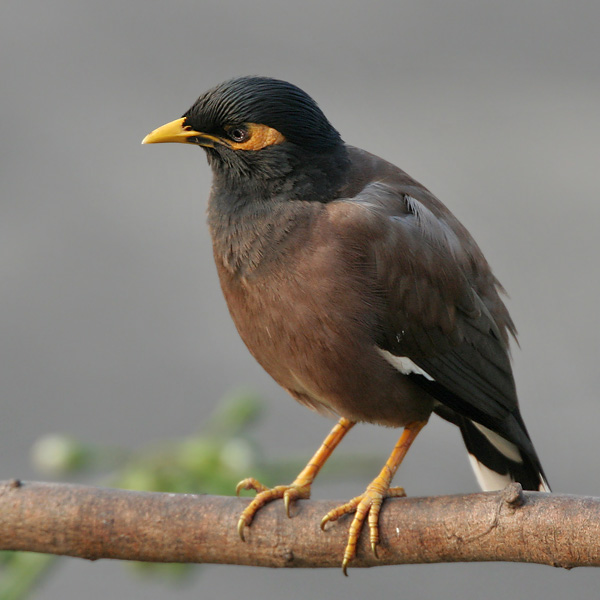Acridotheres tristis
Common Myna
Class: Aves
Order: Passeriformes
Family: Sturnidae

Photographer: J.M.Garg
Source: http://en.wikipedia.org/wiki/Common_myna#mediaviewer
Description
The Common Myna is in the starling family and brownish but is identified by its patch of yellow skin that surrounds the eyes. Adults are 9-9.8 inches long and have a wingspan of 18 inches. In flight, the white tips of the tail feathers and white wing patches are clearly visible. They are known to have very loud calls, squeaks and whistles. Both males and females sing and arte known to strut across the ground, rather than hopping like other birds. They travel in pairs.
Ecological Threat: Common Mynas can cause considerable damage to ripening fruit, particularly grapes, but also figs, apples, pears, strawberries, blueberries, guava, mangoes and breadfruit. Cereal crops such as maize, wheat and rice are susceptible where they occur near urban areas. Roosting and nesting commensal with humans create aesthetic and health concerns. In Hawaii, Mynas are known to carry avian malaria and exotic parasites such as the Ornithonyssus bursia mite which can cause dermatitis in humans. In Florida, they compete with Purple Martins for nest sites, but are not so problematic as in Hawaii. The IUCN has included the Common Myna on its nomination list for “100 of the World’s Worst Invasive Alien Species”.
Biology: Nest building begins in late February and early March and is constructed by both parents. It may be placed in tree cavities, building crevices or even the tops of palm trees. Between March and July females lay 2-5 blue eggs, and both parents incubate the eggs. Chicks hatch in 13-18 days and they fledge when they’re about 4 weeks old. Parental care continues for another month while the young learn to forage for themselves.
History: The Common Myna was brought to Hawaii from India in 1856 by Dr. William Hildebrand in an effort to control army worms (Spodoptera mauritia) and army cutworms (Euxoa auxiliaris) that were destroying sugarcane plots and other pastures. They did help control the cutworm populations but then became adapted to urban life and were prevalent in Honolulu by 1879. Since Common Myna’s can mimic human voices (ie: “talk”) they have been popular for the pet trade. Most Common Myna populations in Florida started with escapes or intentional releases of pet birds. The first confirmed reproducing population was found in Miami in 1983. It has since been reported in 19 other counties and has spread north in Georgia. Thankfully, its numbers have not exploded and small scattered populations seem to be how they live.
U.S. Habitat: These birds prefer open country like farmland and urban parks and yards. In Florida, they seem to prefer shopping mall parking lots. In their native range, they inhabit lowland woodlands on the edges of settlements.
Distribution
Native Origin: India and Southeast Asia
U.S. Present: FL and HI
Management
Luckily not all populations found in Florida are reproducing populations so prevention of distribution expansion is crucial. Importation of the Common Myna has been prohibited in the United States.
Text References
Kale, H. W., II, B. Pranty, B. M. Stith, and C. W. Biggs. 1992. The atlas of the breeding birds of Florida. Final Report. Florida Game and Fresh Water Fish Commission, Tallahassee, Florida.
Woodward, Susan L., and Joyce Ann. Quinn. 2011. Common Myna. Encyclopedia of Invasive Species: From Africanized Honey Bees to Zebra Mussels. Santa Barbara, CA: Greenwood, 232-233. Print.
Internet Sources
http://myfwc.com/wildlifehabitats/nonnatives/birds/common-myrna/
http://www.dpi.nsw.gov.au/agriculture/pests-weeds/vertebrate-pests/pest-animals-in-nsw/myna-birds
http://ibc.lynxeds.com/locality/nearctic/usa-united-states/florida?page=17
http://www.iucnredlist.org/details/106006823/0
http://legacy.myfwc.com/bba/docs/bba_COMY.pdf
 Texas Invasive Species Institute
Texas Invasive Species Institute